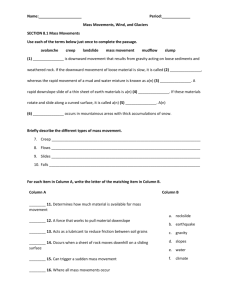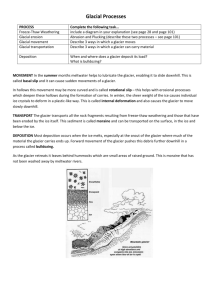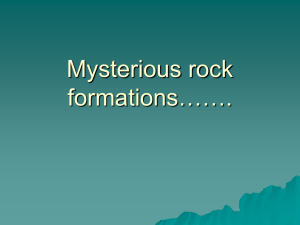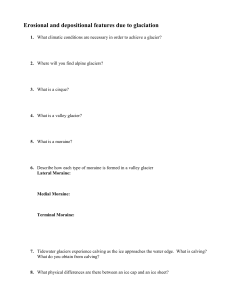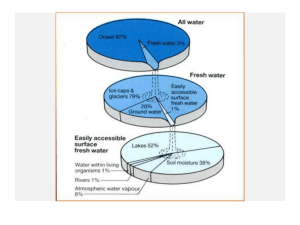Movement of Glaciers Lab
advertisement
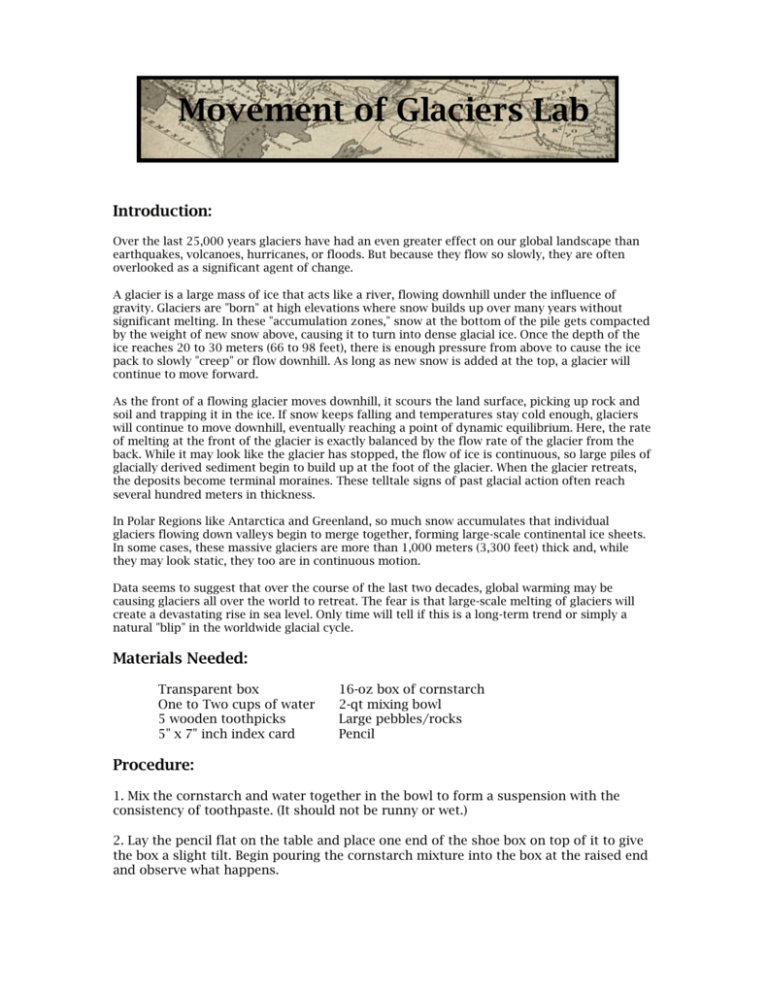
Movement of Glaciers Lab Introduction: Over the last 25,000 years glaciers have had an even greater effect on our global landscape than earthquakes, volcanoes, hurricanes, or floods. But because they flow so slowly, they are often overlooked as a significant agent of change. A glacier is a large mass of ice that acts like a river, flowing downhill under the influence of gravity. Glaciers are "born" at high elevations where snow builds up over many years without significant melting. In these "accumulation zones," snow at the bottom of the pile gets compacted by the weight of new snow above, causing it to turn into dense glacial ice. Once the depth of the ice reaches 20 to 30 meters (66 to 98 feet), there is enough pressure from above to cause the ice pack to slowly "creep" or flow downhill. As long as new snow is added at the top, a glacier will continue to move forward. As the front of a flowing glacier moves downhill, it scours the land surface, picking up rock and soil and trapping it in the ice. If snow keeps falling and temperatures stay cold enough, glaciers will continue to move downhill, eventually reaching a point of dynamic equilibrium. Here, the rate of melting at the front of the glacier is exactly balanced by the flow rate of the glacier from the back. While it may look like the glacier has stopped, the flow of ice is continuous, so large piles of glacially derived sediment begin to build up at the foot of the glacier. When the glacier retreats, the deposits become terminal moraines. These telltale signs of past glacial action often reach several hundred meters in thickness. In Polar Regions like Antarctica and Greenland, so much snow accumulates that individual glaciers flowing down valleys begin to merge together, forming large-scale continental ice sheets. In some cases, these massive glaciers are more than 1,000 meters (3,300 feet) thick and, while they may look static, they too are in continuous motion. Data seems to suggest that over the course of the last two decades, global warming may be causing glaciers all over the world to retreat. The fear is that large-scale melting of glaciers will create a devastating rise in sea level. Only time will tell if this is a long-term trend or simply a natural "blip" in the worldwide glacial cycle. Materials Needed: Transparent box One to Two cups of water 5 wooden toothpicks 5" x 7" inch index card 16-oz box of cornstarch 2-qt mixing bowl Large pebbles/rocks Pencil Procedure: 1. Mix the cornstarch and water together in the bowl to form a suspension with the consistency of toothpaste. (It should not be runny or wet.) 2. Lay the pencil flat on the table and place one end of the shoe box on top of it to give the box a slight tilt. Begin pouring the cornstarch mixture into the box at the raised end and observe what happens. 3. After the mixture has flowed through the entire box, scrape it up with your hand and pile it in the raised end of the box. Use the index cards to make a "dam" across the shoe box valley to hold the mixture back. Lay the five toothpicks across the front of the mixture so that they are one inch apart and parallel to each other. Remove the dam and observe the way the toothpicks move as the glacier flows. 4. After you have tracked the flow of the glacier with the toothpicks, repeat the experiment, but this time place a few large pebbles on the bottom of the shoe box to make obstructions in the valley. Allow the glacier to flow again and observe what happens when it interacts with the obstructions. Analyses and Conclusions: 1. When the cornstarch mixture initially flowed through the box, what shape did the front take? How does this relate to valley glaciers? 2. When you released the mixture from behind the index card "dam," what pattern did the toothpick markers make? What do you think caused this? 3. What happens to the flow of the glacier when it hits the obstructions in the valley? Do you notice anything different in the top of the glacier as it flows over the rocks? 4. What can changes in glacial distribution tell us about changes in climate? 5. A retreating glacier can leave rich soil behind. What areas of the world benefited from this glacial activity?



